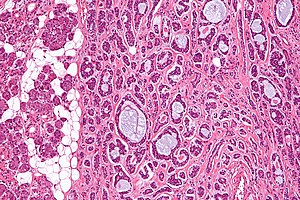Adenoid cystic carcinoma
| Adenoid cystic carcinoma | |
|---|---|
 |
|
| Micrograph of an adenoid cystic carcinoma of a salivary gland (right of image). Normal serous glands, typical of the parotid gland, are also seen (left of image). H&E stain. | |
| Classification and external resources | |
| ICD-O | M8200/3 |
| MeSH | D003528 |
Adenoid cystic carcinoma (sometimes referred to as adenocyst, malignant cylindroma, adenocystic, adenoidcystic, ACC or AdCC.) is a rare type of cancer that can exist in many different body sites. Despite this tumor most often occurs in the salivary glands, it can also be found in many anatomic sites, including the breast,lacrimal gland, lung, brain, bartholin gland, trachea, and the paranasal sinuses.
It is the third most common malignant salivary gland tumor overall (after mucoepidermoid carcinoma and polymorphous low grade adenocarcinoma). It represents 28% of malignant submandibular gland tumors, making it the single most common malignant salivary gland tumor in this region. Patients may survive for years with metastases because this tumor is generally well-differentiated and slow growing. In a 1999 study of a cohort of 160 ACC patients, disease specific survival was 89% at 5 years but only 40% at 15 years, reflecting deaths from late-occurring metastatic disease.
Primary treatment for this cancer, regardless of body site, is surgical removal with clean margins. This surgery can prove challenging in the head and neck region due to this tumour's tendency to spread along nerve tracts. Adjuvant or palliative radiotherapy is commonly given following surgery. For advanced major and minor salivary gland tumors that are inoperable, recurrent, or exhibit gross residual disease after surgery, fast neutron therapy is widely regarded as the most effective form of treatment.Chemotherapy is used for metastatic disease. Chemotherapy is considered on a case by case basis, as there is limited trial data on the positive effects of chemotherapy. Clinical studies are ongoing, however.
...
Wikipedia
